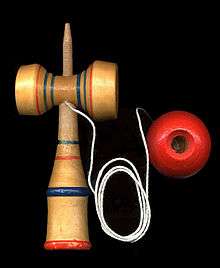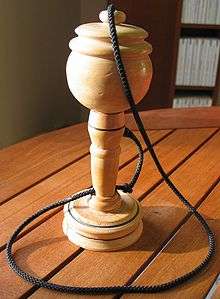Kendama

Kendama (けん玉, also written as 剣玉 and 拳玉) is a traditional Japanese toy. The ken has two cups and a spike which fits into the hole in the ball.
Kendama bears similarities to the classic cup-and-ball game, and the Hispanic world toy known as boliche or balero. The principle of these toys are the same: catching one object with another, where both are joined by a string. However the modern kendama style takes influences from a diverse range of skills including yo-yo, diabolo, juggling and dance.
Structure and terminology
|
History
Origins, precursors, and parallels

The origins of the game are disputed. It has been described as a variation French ball-and-cup game bilboquet which dates to the 16th century. It is generally agreed that Kendama dates to the late 17th or early 18th century.[1]
In Japan
The kendama arrived in Japan from the West in around 1777, at which point Nagasaki was the only port open to foreign trade.[2] Reportedly, kendama was initially a sort of adult's drinking game — a player who made a mistake was forced to drink more.[2] The game gained popularity during the Edo Period (1600-1868).[3]
In the early 20th century, the toy had two side cups and was called a jitsugetsu ball (日月ボール). This translates to 'sun and moon ball', named so because of the ball's representation of the sun and the cups' likeness to the crescent moon.[4]
In 1919, Hamaji Egusa applied for a patent on the 'ball and cup' style toy and it was awarded in 1920. The size and proportions of the toy were later altered. Hatsukaichi City in Hiroshima Prefecture is considered to be the birthplace of the modern Japanese Kendama.[5] The current competition design descends from Issei Fujiwara's model, which featured string holes in the crosspiece. Little deviation has been made from his basic design, with the exception of the ken becoming more rounded to reduce wood chipping. It was also Fujiwara who established the Japan Kendama Association, which established the rules for play, the grading system now in use, and organised competition. To ensure that the toy was suitable for use in competition, the JKA also standardised kendama itself.
Contemporary culture
Today, kendama is popular in many parts of the world. Kendama is particularly well loved in Japan, where national tournaments are held and Japanese employers recognise applicants who have attained the higher dan rankings as "persistent, patient and determined potential employees".
During the 2000s, kendama surged in popularity outside Japan. In 2006 KendamaUSA and the British Kendama Association were founded [6][7] and began to promote kendama in North America and Europe, particularly throughout the juggling and rollerblading communities. As players worldwide began to put videos online, kendama continued to grow and has branched out forming its own global community.
Robotics
Kendama play has also been used as a measure of accuracy, agility, and learning ability in robotic arms.[8][9]
Rules
To play with a kendama, one holds the toy, and pulls the ball upward so that it may either be caught in one of the cups or land with the hole on the spike. More advanced tricks include sequential balances, juggles, and catches. There are eleven prescribed moves on the kendama trick list for achieving a kyu ranking and several more for a dan ranking. A 10-kyu rating (the lowest beginner grade) is attained by simply catching the ball in the largest cup. A book published by the Japan Kendama Association lists 101 different tricks for the toy and there are supposedly tens of thousands of trick variations. Different stances and grips are required to perform different tricks.
While most people play with kendamas for personal satisfaction, competitions do take place, especially in Japan, where many kendama shokūgekìs (Japanese for battle) are held. Participation in such competitions entails performing lists of tricks in sequence or completing particular tricks repeatedly for as long as possible. Additionally, tricks may be performed head to head with a rival to determine a winner. The first competitor to fail a trick loses.
In the trick moshikame (もしかめ), the ball is juggled between the big cup and the smallest cup at the bottom repeatedly. A Japanese children's song of the same name is often sung to help with timing.[10]
Competitions
The Japanese Kendama Association has held kendama contests since 1979.[11]
The British Kendama Association held the first formal kendama contest outside Japan in 2008 at the British Juggling Convention in Doncaster and has been staging a British Kendama Open and European Kendama Open every year since. These contests have taken a variety of formats including trick ladders, speed battles, freestyle, and the head-to-head world championship style.[12]
The Global Kendama Network (Gloken) held the first Kendama World Cup in 2014 in Hatsukaichi, Japan, utilizing a new format whereby players choose 5 tricks from a list of 100 and attempt to complete tricks within a time limit. These tricks are classified according to difficulty into 10 different levels and the player receives points corresponding to the level of the completed trick i.e. a level 7 trick is worth 7 points and but a more difficult level 10 trick is worth 10 points
Gloken Kendama World Cup Winners
2014 - Bonz
2015 - Wyatt Bray / USA / KendamaUSA
2016 - Bryson Lee / USA / Sweets Kendamas
2016 Freestyle (First Time) - Nick Gallagher / USA / Sweets Kendamas
The Minnesota Kendama Open[13] is put on every Fall since 2013 by MN based Sweets Kendamas. MKO is the largest Kendama competition in N. America with many players traveling in from around the USA and the rest of the world. MKO utilizes a few different types of competition to make sure everyone can get involved. Beginner and Intermediate players race through "speed ladders" where a predetermined set of tricks must be completed in order in the fastest time. Advanced/Pro players can compete head-to-head in the Open division where trick cards are pulled at random and players must prove how consistently they can land the tricks. If one players makes the trick and the second misses, the first player gets a point. Rounds are played to 3 points. MKO also showcases a invite-only freestyle competition.
Minnesota Kendama Open Winners
2013 - Max Norcross / USA / Sweets Kendamas
2015 - Lukas Funk / USA / Sweets Kendamas
2016 - Zack Gallagher / USA / Sweets Kendamas
Battle at the Border is an annual kendama event held by Kentucky based kendama company, Sol Kendamas. The very first event was held in Clarksville, TN on October 22, 2011 in a Zaxby's parking lot with just under ten people in attendance. A group of players that went by the name The Kendama Squad consisted of three players; Chad Covington, Nicholas Bellamy, and John Ross Rudolph. While the competition continued to occur annually, the name Battle at the Border wasn't implemented until the 2014 competition. In 2015, the competition reached its largest attendance with over 150 people. Battle at the Border 2015 was held in Nashville, TN on January 3 at Rocketown. This was the year that Sol Kendamas officially took over the event coordination. The next Battle at the Border is scheduled for January 7, 2017.
Battle at the Border Open Winners
2011 - Nicholas Bellamy / USA / Kendama Squad
2012 - Christian Fraser / USA / Sweets Kendamas
2013 - William Penniman / USA / Sweets Kendamas
2014 - Jake Fischer / USA / Kendama Co
2015 - William Penniman / USA / Sweets Kendamas
2016 - Kevin DeSoto / USA / Sol Kendamas
See also
References
- ↑ Ballester, Leeta-Rose (29 April 2015). "San Jose: Wooden toy is such a hit it's prompting kids to take a timeout from video games". San Jose Mercury New. Retrieved 12 December 2015.
- 1 2 "History - Kendama - Virtual Culture - Kids Web Japan - Web Japan".
- ↑ Dorothy Perkins (1991). Encyclopedia of Japan: Japanese History and Culture, from Abacus to Zori. Facts on File. p. 109. ISBN 978-0-8160-1934-2.
- ↑ "What Is Kendama? - Kendama - Virtual Culture - Kids Web Japan - Web Japan".
- ↑ "Kendama". J-higa.net.Template:Verify-source
- ↑ "What is a Kendama?". Kendama USA.
- ↑ "Profile of BKA".
- ↑ Olivier Sigaud; Jan Peters (4 January 2010). From Motor Learning to Interaction Learning in Robots. Springer Science & Business Media. pp. 219–. ISBN 978-3-642-05180-7.
- ↑ Biswa N. Datta (28 July 1999). Applied and Computational Control, Signals, and Circuits. Springer Science & Business Media. pp. 177–. ISBN 978-0-8176-3954-9.
- ↑ Look Japan. Look Japan, Limited. 1987. p. 33.
- ↑ "けん玉協会の沿革".
- ↑ "Kendama World Cup".
- ↑ www.mnkendamaopen.com http://www.mnkendamaopen.com. Missing or empty
|title=(help)
External links
| Wikimedia Commons has media related to Kendama. |
